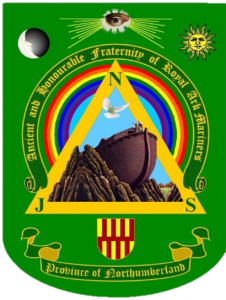
This degree, otherwise known as The Ancient and Honourable Fraternity of Royal Ark Mariners, although worked under the aegis of the Grand Lodge of Mark Master Masons, and requiring every candidate to be a Mark Master Mason, has no historical connection whatsoever with that degree. Mark Grand Lodge’s rule over the ‘Ancient and Honourable Fraternity of Royal Ark Mariners’ is simply a quirk of fate. It stands entirely alone and totally unrelated to any other degree in Freemasonry. In chronological terms it precedes the Mark by hundreds of years because it relates to the building and voyage of Noah’s Ark and the Great Flood and has none of the other characters we meet in Freemasonry. Each one of these orders has its own special place in the Solomonic or Hiramic legend and its place in the Masonic timeline. Each one tells a part of the story and fills in yet another gap in our Masonic knowledge. The Royal Ark Mariner degree has for many years been described as “The Little Gem of a Degree in Freemasonry”, and its members are said to be “Part of the Family” of the two orders.
It is thought it was a originally a degree for carpenters and woodworkers. In the past those trades were more closely associated with stonemasons than is the case today. How can carpenters or woodworkers be considered as masons? When we accept the fact that carpenters and joiners, as well as other trades, were also considered ‘Masons true’ we begin to uncover possible new solutions. The main secret is solved when we realise why we were originally thought of as ‘Noachidae’ or ‘children of Noah’.
In the History of the Carpenters Company of London by Jasper Ridley (1995) it is significant how many times in the 15th and 16th centuries the masons and the carpenters were summoned or charged by the Mayor and Corporation to act together.
It is precisely that kind of interrelation that is reflected in the first sets of Constitutions of the premier Grand Lodge of the Free and Accepted or Speculative Masons of London and Westminster in 1722-23, compiled by the celebrated Dr James Anderson. He first states there:
“Jabal found out Geometry and he divided Flocks of Sheep and Lands; he first built a House of Stone and Timber … and there was a King called Hiram who loved well King Solomon, and he gave him timber for the work.”
Then, in case anyone might miss the inference that not only ‘stone’ workers could be considered ‘Masons’ Anderson added this passage in the following year:
“for then always, Masons, above all other Artists, were the Favourites of the Eminent, and became necessary for their grand Undertakings in any sort of Materials, not only in Stone, Brick, Timber, Plaister; but even in Cloth or Skins, or whatever was used for Tents, and for the various sorts of Architecture.
Nor should it be forgot, that Painters also, and Statuaries, were always recon’d good Masons, much as Builders, Stonecutters, Bricklayers, Carpenters, Joiners, Upholders or Tent-Makers, and a vast many other Craftsman that could be nam’d, who perform according to Geometry, and the Rules of Building; though none since HIRAM ABIF has been renown’d for cunning in all parts of Masonry.”
It would seem therefore that at the very outset of the development of our ritual and legend, following the establishment of the premier Grand Lodge in London in 1717, there was a double source of material from which to draw. The Brethren who devised the ceremonies: that were to become the pattern of 18th century practice in England could avail themselves not simply of those traditional echoes that connected the new ‘Craft’ with stonemasons but with those of the timber-working carpenters as well. What more natural then that in the formation of our 18th century Masonic practice there should be two legend sources relating to the very fundamentals of the Bible story.
The history of the Degree is an obscure and difficult subject and the number of historical facts that have emerged over the years have indeed been small. As a result, the precise origins of the Royal Ark Mariner degree are unknown.
The Degree is around two hundred years old and, like the Mark Master Mason’s Degree, which is based on an established fact (the construction of the Temple at Jerusalem), so the degree of Royal Ark Mariner is also based on an actual happening. As its name suggests, it has a nautical flavour and takes for its scenario the circumstances leading up to, during and after the Great Flood as recorded in the Book of Genesis, and the steps taken by Noah to build the Ark by which mankind was preserved from perishing in the ‘Universal Deluge’.
This event is of such importance as to have impressed itself on the religious dogmas and rites of all nations which have succeeded it. We find allusions to it in the annuls of every people, and some memorial of it in their religious observances. These have served to maintain a veneration for the second parent of the human race, and a great reverence for his historical vessel. The fact of the flood’s existence was verified in 1929 by the archaeologist Sir Leonard Woolley, who not only found clear evidence of the flood, and established that it had occurred some 6,000 years previously but also proved that it had covered an area of some 4000 square miles of what was then Mesopotamia, now Iraq. To the people of that part of the world who probably never travelled beyond the perimeter of their own villages, it must have seemed that the whole world was under water.
The legend of Noah, his sons, the Ark and the Deluge were enacted, generally by the Carpenters Guilds, in the Mystery Plays of the seventeenth century and continued as catechisms in many of the early Masonic rituals. By the 1760s there was a Degree of Noachites or Prussian Knights, now the 21st degree of the Ancient and Accepted Rite. However, the first authentic record of the degree appears in the minutes of a meeting held in Bath in 1790. Numerous records exist throughout the country of the ceremony of Elevation being performed since that date.
Whilst the degree seems to have been practised in a variety of ways and in a host of different Lodges, there was almost certainly no credible Grand Lodge presiding over the degree. We are, of course, reminded of the widespread practice of the degree every time we enter a Craft Lodge where we observe the use of the dove bearing an olive branch by the Deacons rather than Mercury, the winged messenger of the Gods, which we see in many Mark Lodges.
It is interesting to note that, once again, the ubiquitous Thomas Dunkerly, so important in the fortunes of many degrees in Freemasonry was also describing himself in 1793 as Grand Commander of the Society of Ancient Masons of the Diluvian Order of Royal Ark Mariners. It was Dunkerly who appointed one Brother Ebenezer Sibley, another man of considerable ability in several fields, as his Deputy. Shortly before Dunkerley’s death it was Sibley who welcomed Lord Rancliffe as the next Grand Commander. Rancliffe held the office until 1799 after which time the Grand Lodge gradually withered and died. The degree, however, survived and clung on tenaciously in a number of places. In 1843 an attempt was made by Brother John F Dorrington to revive The Grand Lodge of Royal Ark Mariners. It has to be said though, that his Grand Lodge was even less successful than the 1793 body. Morton Edwards, having been Passed to the Chair of Noah, seems to have been fired with the ambition of reviving the Grand Lodge of Royal Ark Mariners. Accordingly, a meeting held on 13 May 1870 in the Bow Road, London house of Brother Dorrington agreed to reconstitute a Grand Lodge.
Since a number of Mark Lodges had also begun to work the degree there was some conflict with The Grand Lodge of Mark Master Masons, which had been formed in 1856. This came to a head when Brother The Reverend Canon Portal, Grand Master of the Grand Lodge of Mark Master Masons announced, also in 1870, that since the degree of Ark Mariner had been worked in Mark Lodges since 1790, the Mark would protect the Royal Ark Mariner degree under a new Grand Master’s Royal Ark Council. This is the reason for Mark Grand Lodge’s current control of the Royal Ark Mariners.
The conflict and dissension continued well after 1870 until the Grand Lodge of Mark Master Masons simply purchased the Degree from Morton Edwards for the sum of £25! The receipt for this transaction still hangs in the library of Mark Mason’s Hall in St. James’s Street, London.
Since that time the Grand Master of the Grand Lodge of Mark Master Masons of England and Wales and its Districts and Lodges Overseas is automatically Grand Master of The Ancient and Honourable Fraternity of Royal Ark Mariners., and therefore, the Provincial Grand Master of the Mark is ipso facto, the Provincial Grand Master of the Degree of Royal Ark Mariners.
The government of the two degrees is inextricably linked and a Royal Ark Mariner Lodge is said to be moored to a Mark Lodge bearing the same number, irrespective of age, and it generally bears the same name. Since the Grand Lodge of Mark Master Masons assumed the responsibility of the Fraternity it has grown steadily with two events being of note. In 1991 it was decided to use the December Communications of Mark Grand Lodge instead as the Annual Meeting of Royal Ark Mariners and since then this meeting has had to be held at Freemason’s Hall, Great Queen Street in order to accommodate the numbers wishing to attend.
The qualification of “Elevation” is, as mentioned above, that of being a Mark Master Mason. The ceremony of Elevation into the Antient and Honourable Fraternity of Royal Ark Mariners is a truly initiatory rite. As in the Craft it is based on the triumvirate of wisdom, strength and beauty, but in this instance, refers particularly to the wisdom of Noah in constructing the Ark, his strength of character and the beauty of his workmanship. But there are other significant messages, and even for the experienced Mason, a powerful reminder of our reliance on a spiritual as well as material enlightenment.
Elevation into the Royal Ark Mariner Degree commemorates the providence and mercy of God and relates to the legend of the deluge. The subject matter being taken directly from the Bible is naturally both beautiful and instructive. When the candidate enters the Lodge room his attention is directed to three points and at one stage the Ark is momentarily symbolised in terms similar to the Ark of Salvation. During the ceremony analogies are drawn between the dangers of the flood and the dangers of life. We are reminded of how we should strive to reach the Ark, the haven of rest, just as did Noah’s family and the other occupants of the Ark in the Biblical tales of the deluge. One interesting feature of the ceremony is the use of a stone, instead of the VSL on which the Obligation is taken. The reason for this is explained in the ritual, but it may be that we have here a survival of swearing on a stone alter, which was the earliest form of swearing an oath. There is also some interesting work with a triangle. Once again, in this degree there are some really beautiful portions of ritual which are guaranteed to make a lasting impression on every candidate. The candidate is finally instructed to advance in the spirit of the Cardinal Virtues.
The teaching of the Degree emphasises the importance of the family strengths and the need for each member of society to play his part for the benefit of all. We are taught that out of chaos and catastrophe mankind can survive and that we should face adversity together, helping to look after those less fortunate than ourselves.
More recently the Tracing Board has been re-introduced, it having been out of favour for over one hundred years. That it could be re-activated was in no small measure due to Gladsmuir Lodge No. 367 (in the Province of Hertfordshire) who had kept a copy of their tracing board. With the assistance of the then senior members of the Province they persuaded the ‘powers that be’ that it would add value to our Lodges and their ceremonial. The Tracing Board is unusual in that it is a legacy from the Craft “Ancients” who practiced Freemasonry on all levels. Although an essential feature of the old Grand Lodge of Ark Mariners, which was functioning under the ubiquitous Dunckerley well before 1790, it portrays not only the origins of the Royal Ark Mariner Degree but also episodes and symbols relating to many Masonic degrees being worked in Masonic Lodges in the 18th Century. Under the English Constitution these degrees, each of them now a Sovereign Grand Order, are today administered by either the United Grand Lodge of England or the Grand Lodge of Mark Master Masons of England and Wales and its Districts and Lodges overseas. Some Royal Ark Mariner Lodges are also starting to revive the use of a special floor cloth which adds much lustre to the ceremonies.
The officers of a Lodge of Royal Ark Mariners are similar to those in a Mark Lodge although they bear different names. The Master is known as The Worshipful Commander, the Secretary as the Scribe, the Inner Guard as the Guardian and the Tyler as the Warder.
The principal officers represent Noah (Worshipful Commander) and his two sons Japheth (SW) and Shem (JW). The wardens sit, as in the craft lodges of old, in the Northwest and Southwest of the Lodge room respectively, the Deacons generally being stationed together in the West.
There is only one ceremony (apart from installation of a Worshipful Commander) and that is the ceremony of Elevation which at around forty-five minutes is relatively short. Only one ritual is used throughout the constitution. The degree has sometimes been dismissed as being of little ritual significance; this impression could not be further from the truth. Those who are ‘Elevated’ as Royal Ark Mariners, and who take the slightest interest in Ark Masonry, soon realize that it is simple and beautiful, rather than superficial or trivial. The presiding officer in a Royal Ark Mariner Lodge, as mentioned earlier, is the Worshipful Commander. The ceremony of his installation is widely considered to be one of the most impressive in Freemasonry.
The regalia comprises an apron which is bordered by a rainbow ribbon with similar rosettes. The breast jewel is of a dove bearing an olive branch suspended from a rainbow attached to a rainbow-coloured ribbon. Commanders and Past Commanders (who are the equivalent of Masters and Past Masters in the Craft) exchange the rosettes on the aprons for silver triangles and wear a breast jewel of a triangle surmounted by the letter N. Provincial Officers wear a collarette from which is suspended a silver ark. Grand Officers exchange the silver detail for gold. There are no individual ranks within either Grand Lodge or Provincial Grand Lodge. Brethren holding those ranks suffix their name with Royal Ark Mariner Grand Rank (RAMGR) or Provincial Royal Ark Mariner Grand Rank (ProvRAMGR). The rainbow ribbon which decorates the regalia of the degree provides a colourful spectacle to all its ceremonies. Despite its great age, it is essentially a thinking man’s degree, conducted in a friendly, intimate and rewarding atmosphere.
If you wish to become a Royal Ark Mariner talk to a Brother in your Mark Lodge; a number will already be a Royal Ark Mariner. They can be distinguished by wearing a RAM jewel suspended from a rainbow ribbon
BREAKING NEWS
 MBF Shines Bright at the Lighthouse Community Hub with a Generous Award of £30,000!
MBF Shines Bright at the Lighthouse Community Hub with a Generous Award of £30,000!
St Cuthbert’s Lodge of Royal Ark Mariners has passed the Travelling Sceptre to Triangle Lodge of Installed Commanders which meets on the 2nd Friday in February, the 1st Tuesday in April (Annual Royal Ark Mariner Assembly – in Ashington Masonic Hall 2026) and holds its Installation Meeting on 2nd Friday on September. All Royal Ark Mariners are welcome to attend the Lodge meetings.
Hexham Lodge of Mark Master Masons No 1141 relinquished the unclaimed Travelling Gavel at our Annual Provincial Meeting on 27th September and it was presented to the Worshipful Master of Nepos Lodge of Mark Master Masons No 1155, which meets at Newcastle East Masonic Building, Corbridge Road, Newcastle upon Tyne NE6 1HY on the third Tuesdays in March (Installation), May, September and November. It’s there to be claimed.
Dates for the Diary:
Check out the latest News:

Thank-you letter from HospiceCare
Thank-you letter from Alnwick District Food Bank
Useful Links: